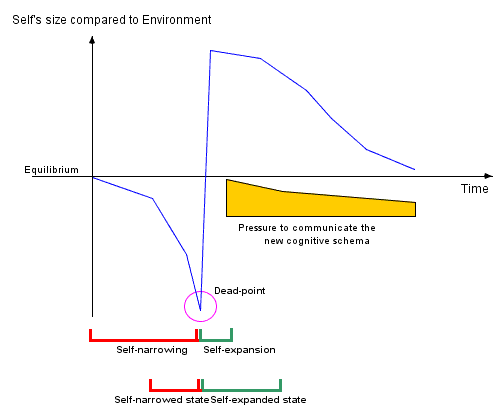- Psychology 2.0
The effects of drugs and smoking on the Self's size
< Sex | List of articles related to FIPP | Intimate relationships >
While playing the video press the "HQ" button (in the right bottom corner of the YouTube player) in order to improve playback quality
Fodormik's Integrated Paradigm for Psychology (FIPP)
Miklos Fodor developed a model based on three basic concepts (later highlighted in bold) that can describe human behavior in different fields of life e.g. problem solving, love, religion, sex, co-operation. The essence of the model is that it reinterprets the relationship of the Self and Environment, which to date has been considered as a static relationship. Thus, the model distinguishes
 Self-narrowing: when the Self perceives the Environment as bigger than itself e.g. in anxiety, fear, making efforts, close attention.
Self-narrowing: when the Self perceives the Environment as bigger than itself e.g. in anxiety, fear, making efforts, close attention.
 Self-expanding: when the Self expands into the Environment and perceives it as a part of itself e.g. love, happiness, aha experience, orgasm.
Self-expanding: when the Self expands into the Environment and perceives it as a part of itself e.g. love, happiness, aha experience, orgasm. The change of the two states can be described with a general pattern, in which the turning point is the emergence of new cognitive schemata, being mental constructions organized on different levels, representing the outside world e.g. concepts, theories, shapes, categories.
The emergence of a new cognitive schema results in a need to communicate, which prompts the Self to associate the new schema with others. The Self-expanding is complete only when such communication occurs.
Example: Problem solving
- Self-narrowing: as we learn more about a problem, finding a solution to it seems to be increasingly hopeless.
- Self-expanding: when the person is about to give up, a new cognitive schema establishes itself, which in turn provides a solution to the problem.
- Communicational pressure: regardless of obtaining a solution to the problem, the person does not experience complete Self-expanding until he can share it with others.
A detailed description of the model and of the basic concepts, with further examples, is provided here.
One virtue of this new model is that it integrates our knowledge of human behavior yet does not contradict psychology’s main discoveries. In addition, it harmonizes with statements of world religions and common sense.
On this page... (hide)
1. Generating Self-expansion and Self-narrowing with chemicals
1.1 Smoking
Although I have no particular points to make on the biochemical processes behind Self-expansion and Self-narrowing, I suspect – as it affects the whole body – that it is connected to hormones. My intuition is supported by the protracted period of onset and then being restored, except the quick switch that follows. If that is so, all of these processes can also be manipulated by the intake of external substances.
One of these substances is cigarette smoke, which consists of several chemicals that have different effects upon the body. Typically, smokers (bar chain-smokers) use cigarettes and tobacco in three different situations:
- when they want to enhance their mental performance
- in company, when they are having a good time
- when they are bored.
Let us examine what happens in each case.
1. Smoking has a effect which also affects the blood vessels of the brain. This enhances circulation and – temporarily – brain activity. Thus far, this is the classic biological/medical explanation. From a psychological viewpoint, cigarette smoke causes Self-narrowing, which focuses our attention, and one can concentrate on something more intensely.
2. Company/society, especially when a meaningful conversation takes place, of itself causes Self-expansion. The Self opens up to the Environment, and is ready to receive outside stimuli. The good mood in this terminology is synonymous with the Self’s possibility for undisturbed expansion, as there are no threatening stimuli present which could make it exposed. There is therefore a friendly, constructive atmosphere that respects the individuality of others. The abovementioned positive effects can occasionally be so intense that it the Self almost over-expands. So, the danger arises of a person becoming too honest and vulnerable. Another point is that the process of expansion is a positive process. This can be enjoyed for long periods if the process is slow. So, smoking serves two purposes. If we accept that smoking narrows the Self, and so can counteract Self-expansion:
a.) it can protect against overexpansion; and
b.) it can regulate speed.
For a more visual example: let us assume that relaxation of the body muscles, and the resulting collapse of the body, is parallel with Self-expansion. The intensity of gravity would be how positive is the effect of the social environment. Smoking would then be the regulator of how fast or slow we fall, and how we fall. It is odd that, according to the above comparison, fainting is equated with orgasm; (unstoppable and very quick).
The question arises: what of people who do not smoke? I have two answers:
- other techniques emerge which can regulate Self-expansion (Self-expansion cannot be regulated from inside because that would mean the end of Self-expansion); and
- if they cannot regulate their Self-expansion using other techniques, they might not enjoy as much the benefits of Self-expansion caused by social situations, but live longer.
- Boredom, from psychology’s viewpoint, is a state of sensory deprivation (too little stimuli). This accompanies the disturbingly low activity of the arousal system. In Self-narrowing the stimuli which reach the person are fewer in number but are more intense. Theoretically, therefore, smoking can intensify the stimuli which reach the brain by narrowing the Self. This requires a stimulus or stimuli worth focusing upon, so it is practical to enhance its intensity. For example, in some cases it is nothing more than the taste of the cigarette, which is not the best solution, as after the first few inhalations people quickly become used to it decreasing its positive effect (not to mention the unpleasant aftertaste).
Other smoking situations can be linked to the slowing down of the process of Self-expansion.
1.2 Drugs
The descriptions of the effects of drugs are oddly similar to those of Self-expansion. Rather than revisit them, I would add just one point of interest: one slang word for a marijuana cigarette is joint, which might come from to the way it was – and is – often smoked: in company, passing it around.
Psychological research demonstrates that the effect of smoking marijuana by oneself is much less intense than smoking it in a social Environment. Despite that, experience still shows that the characteristics of Self-expansion (relaxed state, good mood, agreeableness, openness, enhanced creativity) are displayed just as well.
The end of the big drug-using generation demonstrates that there is no Self-expansion without Self-narrowing. During the 1968 student rebellions and hippy movements, smoking marijuana was fashionable. Moreover, hippies made it a “life philosophy” to “let everybody be Self-expanded” (cf. John Lennon utopian pacifism). However, this resulted in extreme vulnerability and a dramatic decrease in performance, so through evolutionary law, hippie movements ended. As it was enough that only one person displayed aggressive behavior within a hippie community, so pacifism turned into a quasi-dictatorship (compare with Jim Jones cult in Guyana who was not a hippie but a sect leader) at that moment: based on the pacifist philosophy, nobody protested against him, so he could gain unlimited power. As soon as somebody reacted to this aggressive action with aggression the spirit of pacifism vanished.



